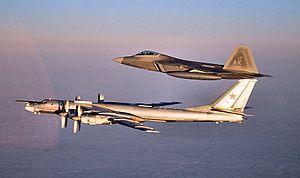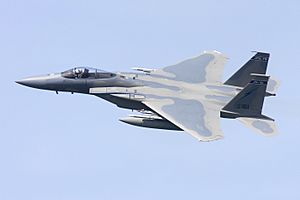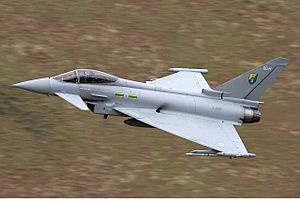Interceptor aircraft facts for kids
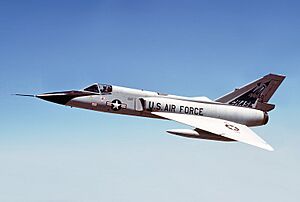
An interceptor aircraft is a special kind of fighter aircraft. Its main job is to stop attacking enemy planes, especially bombers and reconnaissance aircraft. Sometimes, planes that can act as both regular fighters and interceptors are called fighter-interceptors.
There are two main types of interceptors. The first type is a light fighter. These planes are very fast and powerful but can only fly for a short time. The second type is a heavy fighter. These planes can fly longer distances and operate in bad weather or difficult airspaces. In the past, heavy fighters were often special night fighters or all-weather planes. But now, most modern fighter jets can do these jobs. This is because they have features like mid-air refueling, satellite navigation, and advanced radar.
For daytime missions, regular light fighters have often been used as interceptors. They were important in defending skies since World War I. A famous example is the Battle of Britain, where the Supermarine Spitfire and Hawker Hurricane planes helped protect the UK. As radar got better, most new fighter planes could handle the interceptor role. So, fewer planes were built just for daytime interception.
Night fighters and "bomber destroyers" are types of heavy interceptors. During the early Cold War, jet bombers and nuclear weapons made air forces want very powerful interceptors. This is when the term "interceptor" became well-known. Famous interceptors from this time include the Convair F-106 Delta Dart, Sukhoi Su-15, and English Electric Lightning.
By the 1960s and 1970s, aircraft design improved quickly. Many air-superiority and multirole fighters, like the Grumman F-14 Tomcat and McDonnell Douglas F-15 Eagle, became fast enough to intercept enemy planes. Also, the biggest threat changed from bombers to intercontinental ballistic missiles (ICBMs). Because of this, fewer planes were designed only as interceptors. Some later examples include the Panavia Tornado ADV, Mikoyan MiG-25, Mikoyan MiG-31, and Shenyang J-8.
Contents
History of Interceptors
The first groups of interceptor planes were created during World War I. Their job was to protect London from attacks by Zeppelins and later by long-range bombers. Early planes used for this were often older models, like the Sopwith Pup. Pilots were told where to go by a command center. The Pup wasn't fast enough for the Gotha G.IV bombers, so better planes like the Sopwith Camel took over.
The word "interceptor" was used by 1929. In the 1930s, bombers became so fast that it seemed impossible to stop them. Ground detection systems could only see planes a few miles away. This meant interceptors didn't have enough time to get high in the sky before bombers reached their targets. People thought "the bomber will always get through".
Then, radar was invented. Radar could spot planes from about 100 miles away, day or night, in any weather. A bomber might take twenty minutes to fly across the radar's detection area. This gave interceptor pilots enough time to take off, climb, and find the bombers. Systems like the Dowding system in the UK were built to help ground crews guide the interceptors.
When jet engines arrived, plane speeds jumped from about 300 mph to 600 mph. Planes also flew much higher. Even though radar improved, it was still hard to defend against fast attacks. Large attacks could make it difficult for ground crews to talk to pilots. This led to computer systems like the Semi-Automatic Ground Environment in the U.S. to help.
In the 1950s, the first useful surface-to-air missiles (SAMs) appeared. These missiles could launch almost instantly. This meant air forces didn't need interceptors that could react super fast. Instead, they started using much larger interceptors that could fly for a long time. This led to some short-range designs, like the Avro Arrow, being canceled. Larger, longer-range planes like the North American XF-108 Rapier and Mikoyan MiG-25 became more important.
During the Cold War in the 1950s and 1960s, a strong interceptor force was very important. It was the best way for countries to defend against a surprise nuclear attack by strategic bombers. So, interceptors developed very quickly in speed, range, and altitude. But by the late 1960s, nuclear attacks became almost impossible to stop. This was because of ballistic missiles that could fly from outside the atmosphere at incredible speeds. The idea of mutually assured destruction meant that defense wasn't as important. Interceptors became less useful as their role blended with that of heavy air superiority fighters.
Stopping enemy bombers is a very hard job. Bombers can choose where and how they attack. This means they can come from a huge area. An interceptor has to start, take off, climb high, get into position, and attack the bomber all before the bomber reaches its target.
A plane built only as an interceptor often gives up some abilities of a regular air superiority fighter. It focuses on climbing fast and flying at high speeds. This means interceptors often look very impressive on paper. They can usually outrun, outclimb, and outgun slower fighter planes. However, pure interceptors are not very good in fighter-to-fighter combat. They are less agile, especially at low altitudes and speeds.
Interceptor Development in Different Countries
Soviet Union and Russia
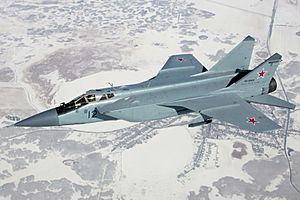
During the Cold War, the Soviet Union had a whole military branch just for interceptors. These were called the Soviet Air Defence Forces (PVO-S). Their planes were not small or simple. They were huge and advanced, with big, complex radars. They needed concrete runways to take off. Their pilots were trained more in following radio directions than in air combat.
The main Soviet interceptor was first the Sukhoi Su-9. Then came the Sukhoi Su-15 and the Mikoyan MiG-25 "Foxbat". The Tupolev Tu-128 was a very heavy fighter plane used for long-range interception. Today, the most advanced interceptor in Russia is the Mikoyan MiG-31 "Foxhound". It improved on the MiG-25, being better at low altitudes and speeds, and it carries an internal cannon. Even though the PVO merged with the regular air force, Russia still uses its dedicated MiG-31 interceptor fleet.
United States
In 1937, two U.S. Army Air Corps lieutenants, Gordon P. Saville and Benjamin S. Kelsey, suggested building interceptor planes. They wanted a single-engine and a twin-engine plane. Both had to reach 20,000 feet in six minutes to stop bombers. Kelsey used the term "interceptor" to get around rules about how much weapons a fighter could carry. He wanted more weapons so American fighters could win against any enemy plane. The planes that came from these ideas were the Bell P-39 Airacobra and the Lockheed P-38 Lightning. Both were successful in World War II as regular fighters.
From 1946 to 1980, the United States had a special command called Aerospace Defense Command. It mostly used dedicated interceptors. Many early post-war designs, like the F-86D Sabre and F-89 Scorpion, had limited performance. In the late 1940s, a project started to build a much more advanced interceptor. This led to the F-106 Delta Dart, which took a long time to develop. Other replacements were considered, but the F-106 remained the main U.S. Air Force interceptor until the 1980s. This was because the Soviet Union started using ICBMs, making bombers less of a threat.
When the F-106 retired, interceptor missions were given to planes like the McDonnell Douglas F-15 Eagle and General Dynamics F-16 Fighting Falcon. The F-16 was first designed for air superiority but became a versatile multirole fighter. The F-15 can fly very fast (Mach 2.5), allowing it to intercept fast enemy planes like the MiG-25. But it's also very agile for dogfighting. The F-15E Strike Eagle version can also attack ground targets. Today, the Lockheed Martin F-22 Raptor is the latest U.S. combat aircraft that acts partly as an interceptor. It can fly super fast without using afterburners, but it was mainly designed as a stealth air superiority fighter.
In the 1950s, the United States Navy tried to develop the F6D Missileer and later the F-111B for fleet air defense, but these projects were canceled. Finally, the Grumman F-14 Tomcat took on this role, carrying AIM-54 Phoenix missiles. Like the F-15, the F-14 was mainly an air superiority fighter. It served as an interceptor until it got upgrades for ground attack in the 1990s. Both the F-14 and the Phoenix missile were retired in 2006.
United Kingdom
The British Royal Air Force used the supersonic English Electric Lightning as a day fighter. They also used the Gloster Javelin for night and all-weather missions. Plans to replace the Javelin with a supersonic plane didn't work out. From the mid-1970s, the UK used its own adapted version of the McDonnell Douglas F-4 Phantom as its main interceptor. In the 1980s, the air defense version (ADV) of the Panavia Tornado was introduced. The Tornado was later replaced by a multirole plane, the Eurofighter Typhoon.
China
The Shenyang J-8 is a fast, high-flying Chinese single-seat interceptor. It was first designed in the early 1960s to counter U.S. planes like the B-58 Hustler bombers, F-105 Thunderchief fighter-bombers, and Lockheed U-2 reconnaissance planes. It can still fly at speeds over Mach 2. Later versions can carry medium-range PL-12 missiles for interception. The Chinese air force still uses about 300 J-8s.
Other Countries
Several other countries also developed interceptor designs. However, in the 1950s and 1960s, many planned interceptors were never built. This was because people thought missiles would replace bombers.
The Argentine FMA I.Ae. 37 was a prototype jet fighter from the 1950s. It was canceled in 1960 and never flew.
The Canadian subsonic Avro Canada CF-100 Canuck was used in the 1950s. Its supersonic replacement, the Avro Canada CF-105 Arrow ("Avro Arrow"), was controversially canceled in 1959.
The Swedish Saab 35 Draken was made to intercept planes flying over Swedish airspace at high altitudes. This was for a possible war between the Soviet Union and NATO. Later, with low-flying cruise missiles, its role changed. But the final version, the J 35J, regained its interceptor profile.
See also
 In Spanish: Interceptor para niños
In Spanish: Interceptor para niños


